Olympiad IV - The maple leaf in London 1908
The first "real" Olympics were also Canada’s first official participation
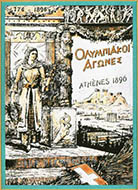 The rejuvenation of the Olympics in Athens in 1896 — now known as the first modern Olympics — was an overwhelming success for the then-newly-formed International Olympic Committee. The games were held on a tight 10-day schedule with 245 athletes representing 14 nations — though Canada was not one of them — and the Greek audiences were enthusiastic and supportive. The marathon emerged as the darling event of the games with the 40 kilometer course inspired by the ancient legend of Athenian herald Pheidippides running from Marathon to Athens. The start line saw 12 Greeks, 2 French, 1 Hungarian, and 1 Australian.
The rejuvenation of the Olympics in Athens in 1896 — now known as the first modern Olympics — was an overwhelming success for the then-newly-formed International Olympic Committee. The games were held on a tight 10-day schedule with 245 athletes representing 14 nations — though Canada was not one of them — and the Greek audiences were enthusiastic and supportive. The marathon emerged as the darling event of the games with the 40 kilometer course inspired by the ancient legend of Athenian herald Pheidippides running from Marathon to Athens. The start line saw 12 Greeks, 2 French, 1 Hungarian, and 1 Australian.
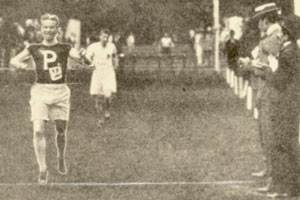
Canadian George Orton wins the 2500m Steeplechase in Paris 1900, representing the University of Pennsylvania. Athleticism was the early emphasis, not nationhood.
But less than a decade later the Olympic Games were ailing and on the ropes. In 1900, the 2nd Olympiad was a sideshow of the Exposition Universelle in Paris, overshadowed and spread out from May to October 1900. Events were held randomly over several months alongside other non-Olympic sporting events. The word “Olympics” was deliberately de-emphasized, not even used in any event programme.
Four years later, Olympiad III in St. Louis, Missouri, would again be a benchwarmer, now upstaged by the St. Louis World’s Fair, and spread out from July to November 1904.
With the next Olympiad set for Rome in 1908, and a planned world’s fair there as well, misgivings permeated throughout the IOC, setting course for a planned rescue. The IOC and Athenian Olympic officials planned an “Intercalated” Games for Athens in 1906 — basically a games-between-the-games — in an attempt to wrest back control of the Olympics from world exposition sideshow. The intercalated plan worked splendidly and the tightly scheduled 11-day event in Athens not only saved the fledgling international sports movement, it also introduced several innovations which would become Olympic traditions, starting wth the first "real" Olympic Games in London 1908.
"Team Canada" in London 1908
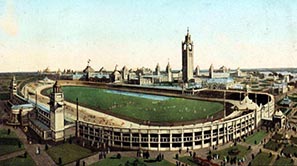 With the eruption of Mount Vesuvius in April 1906, Rome became an unfeasible proposition as host for 1908, so the Olympic Games were switched to London, England, where White City Stadium was quickly constructed at Shepherd’s Bush starting in July 1907. It would be at the IV Olympiad in London in 1908 that the marriage of sports and nationhood truly gripped the world audience. It was in London 1908 that the idea of a "Team Canada" was borne.
With the eruption of Mount Vesuvius in April 1906, Rome became an unfeasible proposition as host for 1908, so the Olympic Games were switched to London, England, where White City Stadium was quickly constructed at Shepherd’s Bush starting in July 1907. It would be at the IV Olympiad in London in 1908 that the marriage of sports and nationhood truly gripped the world audience. It was in London 1908 that the idea of a "Team Canada" was borne.
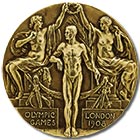 Until now, most athletes had made their own way to the Olympic games as individuals or members of athletic clubs, often travelling through private sponsorship or on their own coin. In Athens 1906, however, the International Olympic Committee had made it compulsory for athletes to register for participation with their own national Olympic organizations. Intercalated Athens also introduced the Opening Ceremonies as a separate opening event unto itself, with athletes filing into the stadium by nation. Gold medal winners would, for the first time, have their flags raised in victorious celebration.
Until now, most athletes had made their own way to the Olympic games as individuals or members of athletic clubs, often travelling through private sponsorship or on their own coin. In Athens 1906, however, the International Olympic Committee had made it compulsory for athletes to register for participation with their own national Olympic organizations. Intercalated Athens also introduced the Opening Ceremonies as a separate opening event unto itself, with athletes filing into the stadium by nation. Gold medal winners would, for the first time, have their flags raised in victorious celebration.
So London 1908 was the first Olympiad to adapt these innovations. Athletes marched into the Opening Ceremonies behind their country banner and their flag. Victors would have their national flags raised before them in celebration. London 1908 would also be the first time Canada officially participated in the Olympics; and the first time our athletic delegation was mainly sponsored by the Canadian government. It would also be the first time our athletes were selected by a Central Olympic Committee (later the Canadian Olympic Association).
And in 1908, for the first time, Canadian athletes uniformly wore the maple leaf as a team.
*****
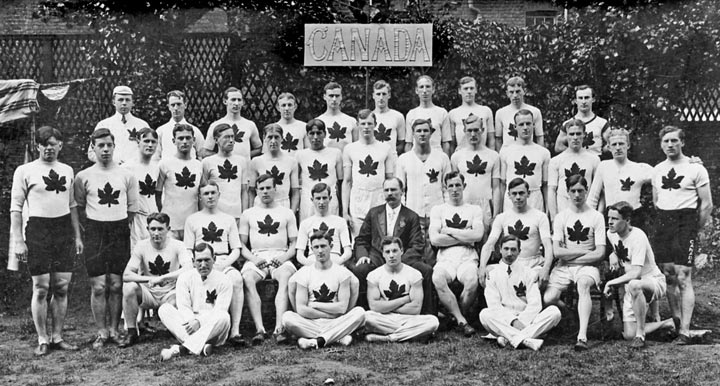
The very first Canadian Team photo, taken on or about 13 July 1908 (the day of the Opening Ceremonies). Represented here is mostly the athletics team, whose events would take place in White City Stadium, except for the marathon which would end in the stadium.
London 1908 was the first Olympiad in which all the athletes had to apply through their official national Olympic committees, such as the Central Olympic Committee in Canada. It was also the first time that all Canadian team members of the stadium events wore the maple leaf.
Not all the Canadian Olympic participants are represented here, since, while the bulk of the Olympics took place between 13 - 25 July, some events took place outside these dates.
In the above photo, reader Dave Mowat identifies his great-grandfather Fred Simpson as seventh from the left in the 2nd row from the top. Fred Simpson was Mississauga Ojibwe, born and raised on the Alderville reserve situated on the south side of Rice Lake. Simpson and Tom Longboat were two Canadian First Nations participants in the 1908 Olympics. (Lewis Tewenima was the 3rd, a Hopi from the US.) Runner Bobby Kerr, gold-medal winner in the 200 metres race, is second from the left in the 2nd row from the bottom. Canadian women would not participate in the Olympics until Chamonix 1924.
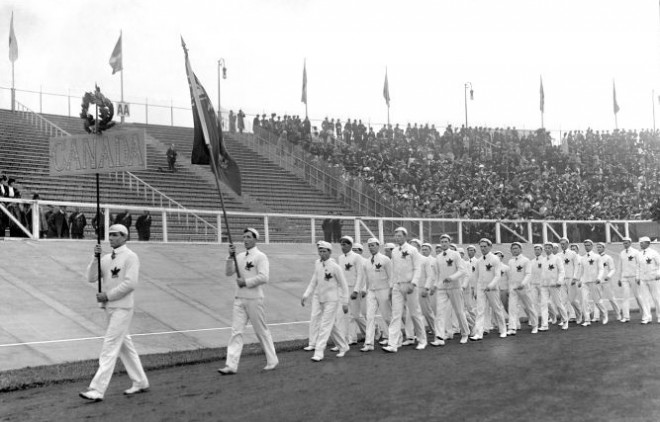
Canadian athletes parade in the Opening Ceremonies on 13th July 1908. London 1908 was the first Olympiad, based on Intercalated Games of 1906, that the athletes entered the stadium under the banners and flags of their nations. Here the Canadian team enters behind the “Canada” banner we see in the “Team Canada” photo above this one. Note the Canadian flag here, carried by Pole vaulter Ed Archibald, is the red ensign, an especially early use of Canada’s unofficial flag. (Canada wouldn’t have an official flag until the current maple leaf flag in 1965.) Marathoner Tom Longboat can be seen 5th man back.
On 13th July 1908, with His Majesty King Edward VII and Queen Alexandra in the Royal Box at White City Stadium, the athletes paraded past by nation, then formed in the field across from the box. The King then said: “I declare the Olympic Games of London open .”
Although London was not part of an Exposition like Paris and St. Louis, some events were still spread over different months, and thus, the "Opening Ceremonies" of 13 July 1908 were really the opening of the Stadium events (athletics, gymnastics, swimming, cycling, wrestling), and thus not all Canadian athletes would be present. The Canadians in the photo above are mostly the athletics competitors, including 12 marathoners. Shooting had already taken place in early July. Rowing wouldn't begin till late July. And lacrosse would not begin till October, along with other autumn sports like soccer, rugby, skating, after a two-month August-September lull of no events at all.
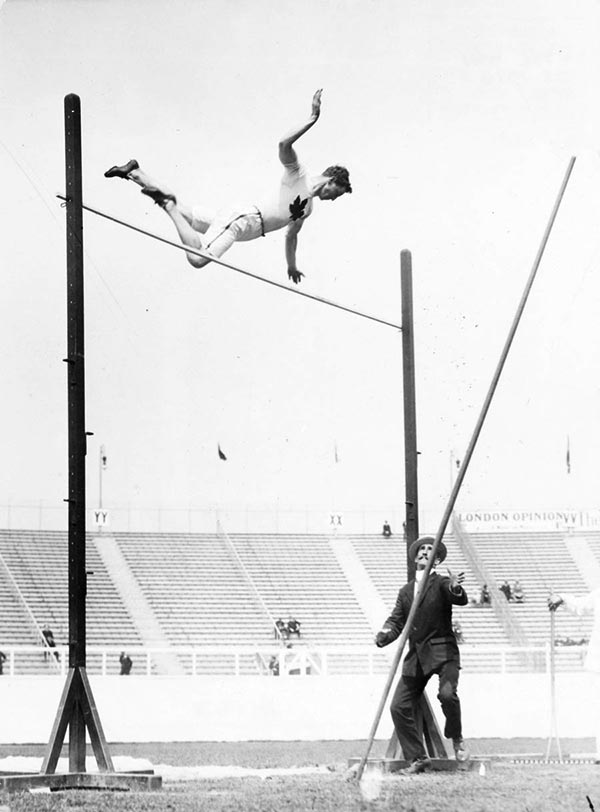
Canadian opening ceremonies flag-bearer Ed Archibald competes in the pole vault competition. He would win a joint 3-way bronze medal, at 3.58m, tied with the American C. Jacobs and the Swede B. Soderstrom. The gold medal was a 2-way tie at 3.71m between Americans ET Cooke and AC Gilbert. All 5 medallists beat the previous Olympic record set in St. Louis. Note the non-existent 1908 pole vault landing pad in London. That's a long drop. (Compare: London 2012 pole vault gold medal was 5.97m; and with a mat.)
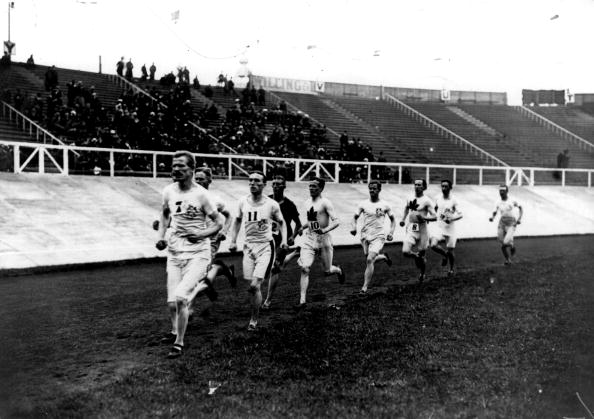
Photo of the Five Mile Race in White City Stadium on 18th July 1908. Emil Voigt of Great Britain leads the pack on his way to the gold medal. The two Canadian runners (see maple leaf on chests) in this final event were J. F. Fitzgerald & F. Meadows, though it is unknown which one is which here. The bib numbers don't match the numbers in the British Olympiad IV book.
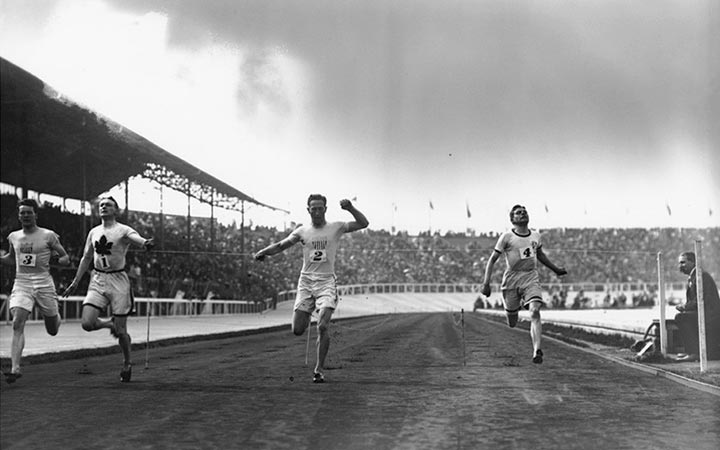
Canadian athlete Bobby Kerr wins a gold medal in the 200 metres at White City Stadium on 23rd July 1908. The previous day he'd won a bronze in the 100m. Kerr was born in Enniskillen, Ireland, and moved to Hamilton, Ontario at 5 years old. He was cheered on by the British audience as an Empire athlete. (Ireland was still part of the British Empire at this point.) Kerr won the Final here in 22.6 seconds. (Compare: London 2012 200m gold medal to Usain Bolt with a time of 19.32 seconds.)
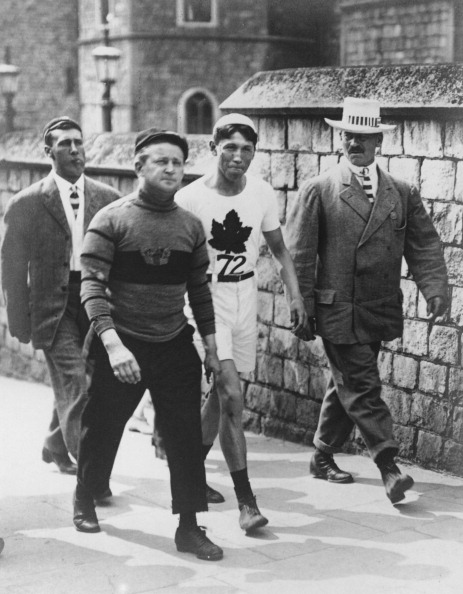
This photo shows Canadian Onondaga marathoner Tom Longboat, probably just before the start of the London 1908 Marathon on 24th July 1908. The building behind is most definitely the entrance to Windsor Castle with the lamp standards and the stepped-stone fence. Marathon favourite Longboat smiles at the photographer as he heads in the direction of the Marathon start line on the Windsor Castle East Terrace. A current view of this photo angle can be seen HERE.

The Marathon was the most glamourous and enthralling event of the early modern Olympics since it was introduced in Athens 1896, inspiring the inaugural Boston Marathon in 1897. Canadian Ronald J. MacDonald won the second Boston Marathon, Jack Caffery won back to back Boston Marathons in 1900 & 1901. Native Onondaga runner Thomas Longboat had won the Toronto Marathon in 1906 and the Boston Marathon in 1907. And with the Intercalated Games in Athens 1906, the final athletics event was again run between Marathon and Athens, this time with Canadian Billing Sherring winning the race. You can imagine the fervour for athletics this propelled back in Canada. In London 1908, no less than 12 Canadians participated in the London Olympics Marathon on 24th July 1908.
You can see a number of maple leaf jerseys in the photo above. The London Marathon began on the East Lawn of Windsor Castle and would finish 40km later in White City Stadium, Shepherd’s Bush. Tom Longboat was the odds-on-favourite and, according to reader Dave Mowat, Longboat's white cap can be seen buried behind the crowd, about six back from fellow First Nations marathoner Fred Simpson who is in the pole position. In the back portion of runners is another Canadian – #74 Burn, in a white hat. Two more Canadians can be seen behind Burn, including #69 Cotter. Canadian runners Wood, Simpson, and Lawson would end up 5th, 6th, 7th respectively. But Longboat collapsed near the end and failed to finish leading to rumours of scandal and tampering.
Canada’s 12 entries in the Marathon, including bib numbers: (64) F. Simpson, (65) H. Lawson, (66) W. Goldsboro, (67) George Goulding, (68) W. Wood, (69) E. Cotter, (70) F. Noseworthy, (71) Jack Caffery, (72) Tom Longboat, (73) G. Lister; (74) A. Burn, (75) J. Tait.
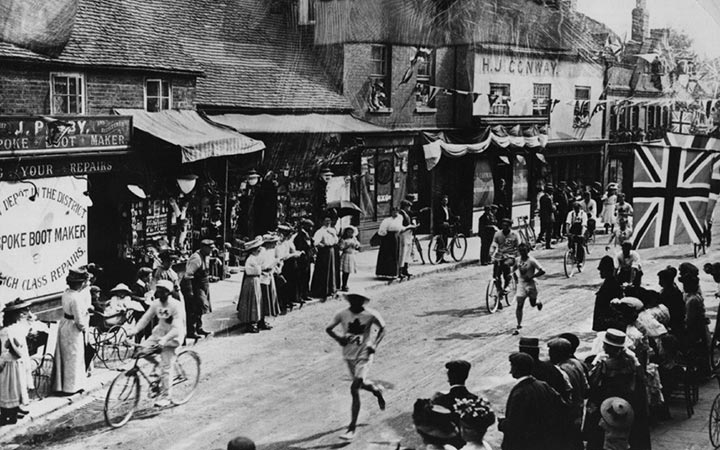
Bib #64 in photo is Canadian marathoner and First Nations runner Fred Simpson, on course between Windsor Castle and White City Stadium, Shepherd’s Bush. Note a coach with the same bib number cycling beside each runner.
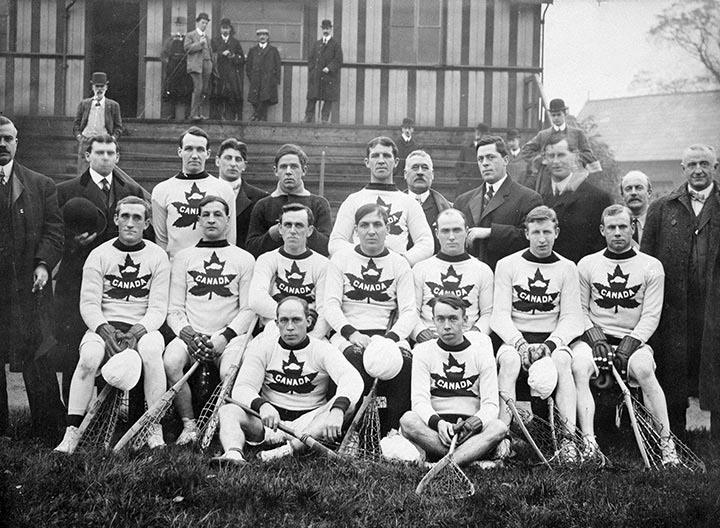
It's late October now. The London Olympics were mainly held from 13 to 25 July 1908 in White City Stadium, but there were to be events held in October 1908 back in the stadium. These events were the autumn team sports such as football association (known as soccer in North America), football rugby, hockey (field hockey that is), and lacrosse.
This is a photo of the Canadian Olympic lacrosse team in England, on or about the date of their match against the United Kingdom on 24th October 1908. Note the different maple leaf designs on their jerseys, including the beaver in the upper portion of the leaf.
Here are the names as MLU can identify. To fill in the blanks or to make any corrections above, please Contact Us.
BACK ROW, standing, left to right: William Foran (Manager) cut off on left; Frank Dixon (goalkeeper with bowler & tie); Clarence D. McKerrow (in Canada jersey); Richard Duckett (player in overcoat); possibly J. Fyon (player in white-collar jersey); D. McLeod (Canada jersey); unknown (older gentleman); Henry Hoobin (player in tie & overcoat); unknown (photo blur); unknown (short bald man with moustache); unknown (probably J. Murphey).
MIDDLE ROW, left to right (sitting): Dr. George H. Campbell (player); Ernest Hamilton; John Broderick; Patrick 'Paddy' Brennan (Captain); G. Rennie; Thomas Gorman; Angus Dillon.
FRONT ROW (on grass): Alexander Turnbull; A. Mara
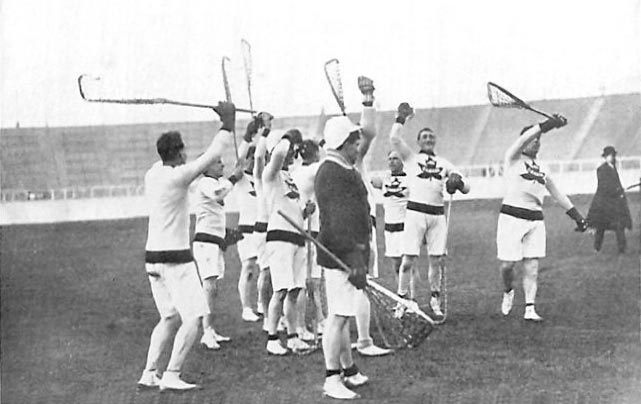
Our first “Team Canada” celebrates its gold-medal 14-10 win over Great Britain team on 24th October 1908. The British team won silver. Unfortunately there were only two teams vying for Olympic gold, and lacrosse was dropped as a sport in subsequent Olympic Games.
London 1908 would be the first time that a true “Team Canada” was selected from the best lacrosse players across the country. Lacrosse at this time was a wildly popular sport in Canada and the team represents many cities and lacrosse clubs across the nation. Lacrosse was our official national sport at the time.
The lacrosse "Team Canada" included players from: St Catherine’s ALC, Dufferin of Orangeville LC, Montreal Shamrock LC, Ottawa Nationals LC, New Westminster LC, Montreal LC, Cornwall LC, Capital LC, Calgary LC, and Young Torontos LC. The UK team was also made up of select lacrosse players from across the UK.
If you have any observations, comments, insights, or see any errata, typos, or anything interesting when viewing these photos, please Contact Us. (Refer to photo reference numbers if possible.)






